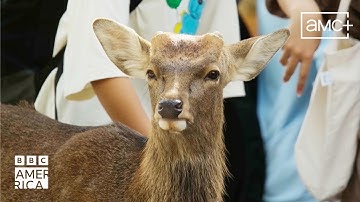
Sika Deer
Cervus nippon

Meet the Sika Deer
The Sika Deer is a medium-sized deer native to East Asia, distinguished by its spotted coat and graceful posture. It displays significant variability in size and coloration, depending on its geographic location, with some populations retaining their spots into adulthood. Sika Deer are highly adaptable and inhabit a variety of forested environments, from temperate woodlands to subtropical forests. They are known for their vocalizations, especially during the rutting season, and exhibit complex social behaviors. Due to introductions, Sika Deer now have established populations outside their native range, including parts of Europe and New Zealand.
Classification
Mammal
Habitat
Forests
Diet
Herbivore
Lifespan
15-20 years
Conservation
Least Concern
Weight
30-70 kg
📖Fascinating Facts
Spotted Coats
Unlike many deer, Sika Deer often retain their white-spotted coats into adulthood, providing camouflage in dappled forest light.
Forest Dwellers
Sika Deer prefer dense forests but are highly adaptable and can thrive in grasslands, marshes, and even mountainous areas.
Vocal Rutting
During the rut, males produce distinctive high-pitched whistles, which can be heard over long distances to attract mates and ward off rivals.
📋Detailed Description
The Sika Deer (Cervus nippon) is a medium-sized cervid, with adult males (stags) typically weighing between 40–70 kg and females (hinds) 30–50 kg, though size varies significantly among subspecies and regions. Their most distinctive feature is their spotted coat, which is retained by many populations into adulthood, unlike most other deer species. The coat color ranges from reddish-brown in summer to darker brown or gray in winter, with pronounced white spots and a characteristic white rump patch bordered by dark hair. Sika deer possess relatively short tails and slender legs, with males bearing antlers that can reach up to 80 cm in length, usually with three to four tines per antler. They are highly vocal, especially during the rut, producing a range of calls including whistles, screams, and barks. Sika deer are crepuscular, being most active at dawn and dusk, and exhibit both solitary and group-living behaviors depending on season and habitat. Their diet consists mainly of grasses, leaves, shoots, and occasionally bark, making them important ecological browsers. Social structure is fluid, with females and their young forming small herds, while males are often solitary or form bachelor groups outside the breeding season. Sika deer are adaptable and thrive in a variety of forested habitats, from dense temperate woodlands to subtropical forests, and have established feral populations in several countries outside their native range.
💡 Did you know?
Sika Deer have been introduced to several countries outside their native range and are considered an invasive species in some places due to their impact on local ecosystems.
🔬Research & Sources
Wikipedia Summary
The sika deer, also known as the northern spotted deer or the Japanese deer, is a species of deer native to much of East Asia and introduced to other parts of the world. Previously found from northern Vietnam in the south to the Russian Far East in the north, it was hunted to the brink of extinction in the 19th century. Protection laws were enacted in the mid-20th century, leading to a rapid recovery of their population from the 1950s to the 1980s.
Last Modified: 5/25/2025
🎭Behavior & Social Structure
Sika deer display a wide range of behavioral patterns influenced by season, habitat, and population density. They are primarily crepuscular, foraging during early morning and late evening hours to avoid predators and human disturbance. Feeding behavior is selective; they prefer tender grasses, sedges, and herbaceous plants, but will browse on shrubs and tree shoots when necessary. During the rutting season (typically September to November), males become highly territorial, marking their ranges with scent from preorbital glands and engaging in vocal displays and antler fights to attract females and deter rivals. Outside the breeding season, social organization is less rigid, with females and juveniles forming loose herds and males often remaining solitary. Sika deer are known for their agility and can swim well, which aids in escaping predators and traversing fragmented landscapes. They use a variety of vocalizations for communication, including alarm barks, maternal calls, and the high-pitched whistles of rutting males.
👶Reproduction & Life Cycle
The breeding season, or rut, occurs from late September to early November, varying with latitude and local climate. Males establish territories and compete for access to females through vocalizations, displays, and physical combat. After mating, gestation lasts approximately 210–220 days, with most births occurring in late spring or early summer (May to June). Females typically give birth to a single fawn, though twins are rare but possible. Newborns are well-camouflaged with prominent white spots and remain hidden in dense vegetation for the first few weeks, visited by the mother only for nursing. Weaning occurs at around 6–8 weeks, but fawns may stay with their mothers for up to a year. Sexual maturity is reached at 16–18 months for females and 18–24 months for males, though males may not breed successfully until older due to competition.
🛡️Adaptations & Survival
Sika deer exhibit several adaptations for survival in diverse environments. Their spotted coat provides effective camouflage in dappled forest light, reducing predation risk. The ability to retain spots into adulthood is unique among many deer species and is thought to be an adaptation to their woodland habitats. Sika deer have well-developed senses of smell, hearing, and vision, aiding in predator detection and social communication. Their vocal repertoire, especially the loud whistles of stags, is adapted for long-distance communication in dense forests. Physiologically, they can digest a wide variety of plant materials, allowing them to exploit different food resources. Behavioral flexibility, including the ability to form variable social groups and adapt activity patterns, has facilitated their success in both native and introduced ranges.
🎨Cultural Significance
Sika deer hold considerable cultural importance, especially in Japan, where they are considered messengers of the gods in Shinto tradition and are protected in places like Nara Park. They appear in folklore, art, and literature throughout East Asia and have been hunted for meat, hides, and antlers for centuries. In China and Korea, Sika deer antlers (velvet) are used in traditional medicine. The deer’s graceful appearance and vocalizations have inspired numerous legends and are symbolic of longevity and good fortune in various cultures.
🔬Recent Research & Discoveries
Recent research has focused on the genetic diversity of Sika deer populations, particularly the extent of hybridization with red deer in areas of overlap, which poses conservation challenges. Studies on their ecological impact in introduced ranges, such as the UK and New Zealand, have highlighted their role in altering forest structure and plant communities. Ongoing work includes satellite tracking to understand movement ecology, behavioral studies on rutting strategies, and investigations into disease transmission between wild and domestic ungulates. Advances in molecular genetics have clarified subspecies relationships and informed management strategies for both conservation and control.
🎥Wildlife Videos

The Antler-less Sika Deer Of Japan | Asia | BBC America
Trimming a Sika's antlers keeps their community safe in the spring, and they can hold their own even without their biggest weapon ...
BBC America

City Where People Live Alongside Deer | Asia | BBC Earth
In the city of Nara, Japan, not all morning commuters walk on two legs. Sika deer are more than comfortable in this town and are ...
BBC Earth

The Sika Deer - The British Mammal Guide
The Sika Deer - A clip from the British Mammal Guide DVD For more information visit - www.isabelline.co.uk.
Steve Evans

The Return of the Vietnamese Sika Deer: A Miracle in the Wild
After decades of silence in Vietnam's wilderness, the elusive Vietnamese Sika Deer — once thought to be extinct — is showing ...
Beastly Biomes

Seeking The Sika Deer
On the hunt for a Throphy Sika Deer in the marshes of Dorchester County. A story of patience, hunting humor, failure, and success ...
Weavennnn

Sika Deer: Noble Creatures
Welcome to the world of sika deer, those enchanting creatures that have captivated the hearts of nature enthusiasts around the ...
Lord of Animals
🌍Habitat Information
The Sika Deer typically inhabits Forests environments. Sika Deers have adapted to their environments with specialized features and behaviors.
Primary Habitat:
Forests
More detailed habitat information will be available soon.
🛡️Conservation Status
The Sika Deer is currently classified as Least Concern. Conservation efforts are crucial for preserving this species for future generations.
Common Threats:
- 🏠Habitat loss and fragmentation
- 🌡️Climate change impacts
- 🎯Hunting and poaching
- 🏭Human-wildlife conflict
⚠️Threats & Conservation Challenges
Historically, Sika deer populations suffered severe declines due to overhunting and habitat loss, particularly in Japan and mainland Asia. By the early 20th century, some subspecies were extinct or reduced to small remnant populations. Conservation measures, including legal protection and reintroduction programs, have enabled significant recovery in many areas. However, ongoing threats include habitat fragmentation, hybridization with other deer species (notably red deer in Europe), and competition with livestock. In introduced ranges, Sika deer can become invasive, outcompeting native species and causing ecological damage through overbrowsing and hybridization. Population trends are generally stable or increasing in most regions, but some isolated subspecies remain at risk.
🔬Scientific Classification
Scientific Name
Cervus nippon
Classification Hierarchy
🔍 About Taxonomic Classification
Taxonomic classification is a hierarchical system used by scientists to classify and organize living organisms based on shared characteristics and evolutionary relationships.
The system moves from broad categories (Kingdom) to increasingly specific ones, with each animal's scientific name typically consisting of its Genus and species.
📝Community Notes
Share your observations and insights about the Sika Deer with our community of wildlife enthusiasts.
Join Our Community
Sign in to share your observations and connect with fellow wildlife enthusiasts.
Sign In to ContributeNo community notes yet
Be the first to share your observations about the Sika Deer!
Explore Sika Deer
Select a tab above to learn more about this amazing animal.
📸Photo Gallery
No photos available for this animal yet.
🌟Discover More Wildlife
Continue your journey of discovery with more fascinating animals from our database
